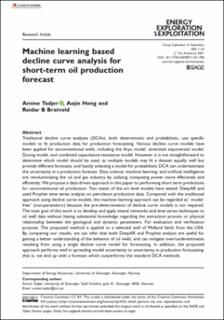| dc.contributor.author | Tadjer, Mohamed Amine Amazigh | |
| dc.contributor.author | Hong, Aojie | |
| dc.contributor.author | Bratvold, Reidar Brumer | |
| dc.date.accessioned | 2021-06-01T07:48:13Z | |
| dc.date.available | 2021-06-01T07:48:13Z | |
| dc.date.created | 2021-05-25T17:17:55Z | |
| dc.date.issued | 2021-05 | |
| dc.identifier.citation | Tadjer, A., Hong, A., Bratvold, R.B. (2021) Machine learning based decline curve analysis for short-term oil production forecast. Energy exploration & exploitation. | en_US |
| dc.identifier.issn | 0144-5987 | |
| dc.identifier.uri | https://hdl.handle.net/11250/2757144 | |
| dc.description.abstract | Traditional decline curve analyses (DCAs), both deterministic and probabilistic, use specific models to fit production data for production forecasting. Various decline curve models have been applied for unconventional wells, including the Arps model, stretched exponential model, Duong model, and combined capacitance-resistance model. However, it is not straightforward to determine which model should be used, as multiple models may fit a dataset equally well but provide different forecasts, and hastily selecting a model for probabilistic DCA can underestimate the uncertainty in a production forecast. Data science, machine learning, and artificial intelligence are revolutionizing the oil and gas industry by utilizing computing power more effectively and efficiently. We propose a data-driven approach in this paper to performing short term predictions for unconventional oil production. Two states of the art level models have tested: DeepAR and used Prophet time series analysis on petroleum production data. Compared with the traditional approach using decline curve models, the machine learning approach can be regarded as” model-free” (non-parametric) because the pre-determination of decline curve models is not required. The main goal of this work is to develop and apply neural networks and time series techniques to oil well data without having substantial knowledge regarding the extraction process or physical relationship between the geological and dynamic parameters. For evaluation and verification purpose, The proposed method is applied to a selected well of Midland fields from the USA. By comparing our results, we can infer that both DeepAR and Prophet analysis are useful for gaining a better understanding of the behavior of oil wells, and can mitigate over/underestimates resulting from using a single decline curve model for forecasting. In addition, the proposed approach performs well in spreading model uncertainty to uncertainty in production forecasting; that is, we end up with a forecast which outperforms the standard DCA methods. | en_US |
| dc.language.iso | eng | en_US |
| dc.publisher | SAGE Publishing | en_US |
| dc.rights | Attribution-NonCommercial-NoDerivatives 4.0 Internasjonal | * |
| dc.rights.uri | http://creativecommons.org/licenses/by-nc-nd/4.0/deed.no | * |
| dc.subject | maskinlæring | en_US |
| dc.subject | oljeproduksjon | en_US |
| dc.title | Machine learning based decline curve analysis for short-term oil production forecast | en_US |
| dc.type | Peer reviewed | en_US |
| dc.type | Journal article | en_US |
| dc.description.version | publishedVersion | en_US |
| dc.rights.holder | © The Author(s) 2021 | en_US |
| dc.subject.nsi | VDP::Teknologi: 500::Berg‑ og petroleumsfag: 510 | en_US |
| dc.source.pagenumber | 23 | en_US |
| dc.source.journal | Energy exploration & exploitation | en_US |
| dc.identifier.doi | 10.1177/01445987211011784 | |
| dc.identifier.cristin | 1911781 | |
| cristin.ispublished | true | |
| cristin.fulltext | original | |
| cristin.qualitycode | 1 | |

